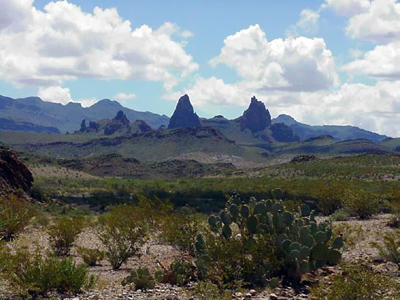Air pollution can damage resources that national parks are mandated to protect, such as vegetation, wildlife, soils, surface waters, visibility, and night skies. The National Park Service (NPS) has the responsibility to remedy and prevent damage to air quality.

NPS
Three parks in the Chihuahuan Desert Network (Big Bend National Park (NP), Carlsbad Caverns NP, and Guadalupe Mountains NP) are designated as Class I air quality areas under the Clean Air Act (CAA). Class I areas receive the highest protection under the act, and degradation of air quality must be minimal. The remaining parks in the Chihuahuan Desert Network are designated as Class II air quality areas, in which only limited amounts of new emissions are allowed. Air quality concerns include atmospheric deposition effects and visibility impairment from fine particle haze. For example, deposition of atmospheric nitrogen can lead to soil changes that affect soil microorganisms and plants. Excess nitrogen can lead to changes in plant community diversity and structure, including an increase in the occurrence of invasive exotic species.
Status and Trends
A number of air quality monitoring stations are located in or near Chihuahuan Desert Network parks to monitor ozone, wet and dry deposition of atmospheric pollutants (e.g., sulfur dioxide, nitrogen oxides, and ammonia), and visibility. In situations where there are no monitors in close proximity to a park, NPS Air Atlas estimates are used for information.

In general, wet deposition and concentrations of sulfate, nitrate, and ammonium are lower in the western U.S. than in the Midwest and East. Using monitoring data from 2003-2007 to generate interpolations for the continental U.S., the NPS assessed air quality condition (i.e., good, moderate, or of significant conern) for a number of park units across the country. Three Chihuahuan Desert Network parks and Chamizal National Memorial (NMem; El Paso) were included in the assessment. At Big Bend NP, air quality was determined to be in moderate condition with regard to visibility, sulfur deposition, and ozone; nitrogen deposition is of significant concern. At Carlsbad Caverns NP, air quality is in moderate condition with regard to visibility and at Chamizal NMem, air quality is in moderate condition with regard to ozone. At Guadalupe Mountains NP, air quality was determined to be in moderate condition in terms of visibility and sulfur deposition, but nitrogen deposition is of significant concern.

NPS
NPS also used 1998-2007 data to assess trends in individual park air quality. Data came from air quality monitors inside park boundaries, within 10 miles of parks (for ozone and deposition), and within 100 kilometers of parks (for visibility). For Big Bend NP, Carlsbad Caverns NP, and Guadalupe Mountains NP, improving trends in visibility were recorded for the clearest days, and to a lesser extent (i.e., not statistically significant, 0.05<p≤0.15) on the haziest days. Sulfate concentrations showed an improving trend at Guadalupe Mountains NP, but no change at Big Bend NP. Nitrate concentrations showed an improving trend at Guadalupe Mountains and Big Bend NPs, although the change at Big Bend was not statistically significant. Trends in ammonium concentration were either improved but not statistically significant (Guadalupe Mountains NP), or stable (Big Bend NP). At Big Bend NP, trends in ozone were stable, while those at Chamizal NMem had somewhat improved.
A 2004 ozone risk assessment for Chihuahuan Desert Network parks (using 1995-1999 data) determined that Amistad National Recreation Area (NRA) is at moderate risk for ozone injury to plants, whereas the remaining units are at low risk. High levels of ozone may affect vegetation by causing foliar injury and growth effects. Even though Amistad NRA is considered to be at moderate risk, no ozone-sensitive plant species have been identified there. Other parks (Big Bend NP and Fort Davis National Historic Site [NHS]) are known to have ozone-sensitive plants.
Discussion

Dustin Nelson / NPS
Presently, concerns exist for all three of the parks designated as Class I areas— increasing oil and gas development around Carlsbad Caverns and Guadalupe Mountains NPs may lead to increased sulfur and nitrate pollutants, and a rapid decrease in soil pH has been documented in Big Bend NP grasslands. Studies begun in 2003 to assess the impacts of atmospheric nitrogen deposition and climate change on desert ecosystems, as well as continued monitoring in and near parks, will help determine potential threats and/or impacts from these pollution sources.
Prepared by Patty Valentine-Darby, Chihuahuan Desert Network Inventory and Monitoring Program, 2010.
Tags
- amistad national recreation area
- big bend national park
- carlsbad caverns national park
- chamizal national memorial
- fort davis national historic site
- guadalupe mountains national park
- rio grande wild & scenic river
- white sands national park
- swscience
- american southwest
- chihuahuan desert
- chdn
- air quality
- monitoring
- project
Last updated: November 25, 2018
